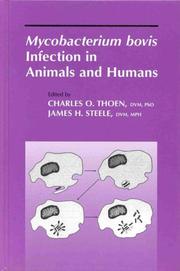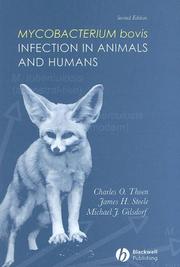| Listing 1 - 8 of 8 |
Sort by
|

ISBN: 0813821207 Year: 1995 Publisher: Ames, Iowa : Iowa State University Press,
Abstract | Keywords | Export | Availability | Bookmark
 Loading...
Loading...Choose an application
- Reference Manager
- EndNote
- RefWorks (Direct export to RefWorks)
AIDS (Disease) --- Mycobacterium bovis. --- Tuberculosis in cattle. --- Tuberculosis. --- Complications.
Book
ISBN: 9781118474297 Year: 2014 Publisher: Ames : Wiley-Blackwell,
Abstract | Keywords | Export | Availability | Bookmark
 Loading...
Loading...Choose an application
- Reference Manager
- EndNote
- RefWorks (Direct export to RefWorks)
Mycobacterium bovis. --- Tuberculose bovine. --- Tuberculose. --- Zoonoses. --- Éradication des maladies. --- Mycobacterium bovis --- Tuberculosis, bovine --- Tubesculosis --- Tuberculosis --- Zoonoses --- Disease Eradication --- pathogenicity --- veterinary --- microbiology --- Mycobacterium bovis --- Tuberculosis, bovine --- Tubesculosis --- Tuberculosis --- Zoonoses --- Disease Eradication --- pathogenicity --- veterinary --- microbiology

ISBN: 0813809193 9780813809199 Year: 2006 Publisher: Ames : Blackwell Publishing,
Abstract | Keywords | Export | Availability | Bookmark
 Loading...
Loading...Choose an application
- Reference Manager
- EndNote
- RefWorks (Direct export to RefWorks)
Mycobacterium bovis --- Tuberculosis, bovine --- Tuberculosis, bovine --- Tuberculosis, bovine --- Tubesculosis --- Public health --- epidemiology --- diagnosis --- economics --- Mycobacterium bovis --- Tuberculosis, bovine --- Tuberculosis, bovine --- Tuberculosis, bovine --- Tubesculosis --- Public health --- epidemiology --- diagnosis --- economics
Dissertation
ISBN: 9782930404967 Year: 2011 Publisher: Liège : Presses de la Faculté de Médecine Vétérinaire de l'Université de Liège,
Abstract | Keywords | Export | Availability | Bookmark
 Loading...
Loading...Choose an application
- Reference Manager
- EndNote
- RefWorks (Direct export to RefWorks)
Cattle --- Cattle diseases --- Tuberculosis, bovine --- Zoonoses --- Ecuador --- Mycobacterium bovis --- epidemiology --- diagnosis
Book
Year: 2004 Publisher: Beltsville, Md. : U.S. Dept. of Agriculture, Agricultural Research Service, National Agricultural Library, Animal Welfare Information Center,
Abstract | Keywords | Export | Availability | Bookmark
 Loading...
Loading...Choose an application
- Reference Manager
- EndNote
- RefWorks (Direct export to RefWorks)
The focus of this publication is on information related to tubercular diseases of animals caused by the bacterial genus Mycobacterium. Livestock diseases are mostly caused by Mycobacterium bovis and the Mycobacterium tuberculosis complex. Many species of animals are included: large ruminants, wildlife, wild animals as disease reservoirs, deer, elephants, birds, fish, etc. Topics are varied and include clinical aspects of the disease, the disease process, disease prevention and control, vaccines, immunology, bacterial genetics, zoonotic aspects etc.
Tuberculosis in animals --- Mycobacterium --- Mycobacterium avium --- Mycobacterium bovis --- Tuberculosis in poultry --- Zoonoses
Dissertation
Year: 1988 Publisher: S.l. s.n.
Abstract | Keywords | Export | Availability | Bookmark
 Loading...
Loading...Choose an application
- Reference Manager
- EndNote
- RefWorks (Direct export to RefWorks)
Antigens, Bacterial --- Cloning, Molecular --- Mycobacterium bovis --- DNA, Bacterial --- Escherichia coli --- immunology --- genetics --- biosynthesis
Dissertation
Year: 1984 Publisher: [S. l.] : [chez l'auteur],
Abstract | Keywords | Export | Availability | Bookmark
 Loading...
Loading...Choose an application
- Reference Manager
- EndNote
- RefWorks (Direct export to RefWorks)
INTERLEUKIN-2 --- MYCOBACTERIUM BOVIS --- INTERFERON TYPE II --- T-LYMPHOCYTES, CYTOTOXIC --- CLONE CELLS --- ANTIBODIES, NEOPLASM --- MICE --- INTERLEUKIN-2 --- MYCOBACTERIUM BOVIS --- INTERFERON TYPE II --- T-LYMPHOCYTES, CYTOTOXIC --- CLONE CELLS --- ANTIBODIES, NEOPLASM --- MICE
Book
ISBN: 3039280112 3039280104 9783039280117 Year: 2020 Publisher: MDPI - Multidisciplinary Digital Publishing Institute
Abstract | Keywords | Export | Availability | Bookmark
 Loading...
Loading...Choose an application
- Reference Manager
- EndNote
- RefWorks (Direct export to RefWorks)
Humans are part of an ecosystem, and understanding our relationship with the environment and with other organisms is a prerequisite to living together sustainably. Zoonotic diseases, which are spread between animals and humans, are an important issue as they reflect our relationship with other animals in a common environment. Zoonoses are still presented with high occurrence rates, especially in rural communities, with direct and indirect consequences for people. In several cases, zoonosis could cause severe clinical manifestations and is difficult to control and treat. Moreover, the persistent use of drugs for infection control enhances the potential of drug resistance and impacts on ecosystem balance and food production. This book demonstrates the importance of understanding zoonosis in terms of how it allows ecosystems to transform, adapt, and evolve. Ecohealth/One Health approaches recognize the interconnections among people, other organisms, and their shared developing environment. Moreover, these holistic approaches encourage stakeholders of various disciplines to collaborate in order to solve problems related to zoonosis. The reality of climate change necessitates considering new variables in studying diseases, particularly to predict how these changes in the ecosystems can affect human health and how to recognize the boundaries between medicine, veterinary care, and environmental and social changes towards healthy and sustainable development.
Zoonoses --- Epidemics --- Animals --- Prevention. --- Diseases --- One Health (Initiative) --- Animal kingdom --- Beasts --- Fauna --- Native animals --- Native fauna --- Wild animals --- Wildlife --- Organisms --- Human-animal relationships --- Zoology --- Disease outbreaks --- Outbreaks of disease --- Pandemics --- Pestilences --- Communicable diseases --- Animal-borne diseases --- Communicable diseases between animals and human beings --- Zoonotic diseases --- Animals as carriers of disease --- Outbreaks --- non-typhoidal Salmonella --- bacteria --- spotted fever group Rickettsia spp. --- environmental DNA --- filariasis --- enteropathogens --- Anaplasma phagocytophilum --- antimicrobial resistance --- livestock --- serology --- multiple correspondence analysis (MCA) --- animals --- bovine tuberculosis (bTB) --- Enterobacteriaceae --- risk factors --- Tocantins --- B. malayi --- Africa --- zoonoses --- Zoonosis --- wildlife–livestock–human interface --- tick-borne infections --- zoonosis --- snail surveillance --- IFAT --- edaphic factors --- D. immitis --- Oncomelania hupensis quadrasi --- antibiotics --- Taenia saginata --- dog --- PCR --- food chain --- Cysticercus bovis --- schistosomiasis japonica --- campylobacteriosis --- one health --- birds --- Thailand --- epidemiology --- antibiotic resistance --- One-health --- ESBL --- public health --- One Health --- child diarrhoea --- Eastern Mediterranean region --- Mycobacterium bovis (M. bovis) --- zoonotic TB --- Toxoplasma gondii --- developing countries --- food security --- B. pahangi --- horses
| Listing 1 - 8 of 8 |
Sort by
|

 Search
Search Feedback
Feedback About UniCat
About UniCat  Help
Help News
News